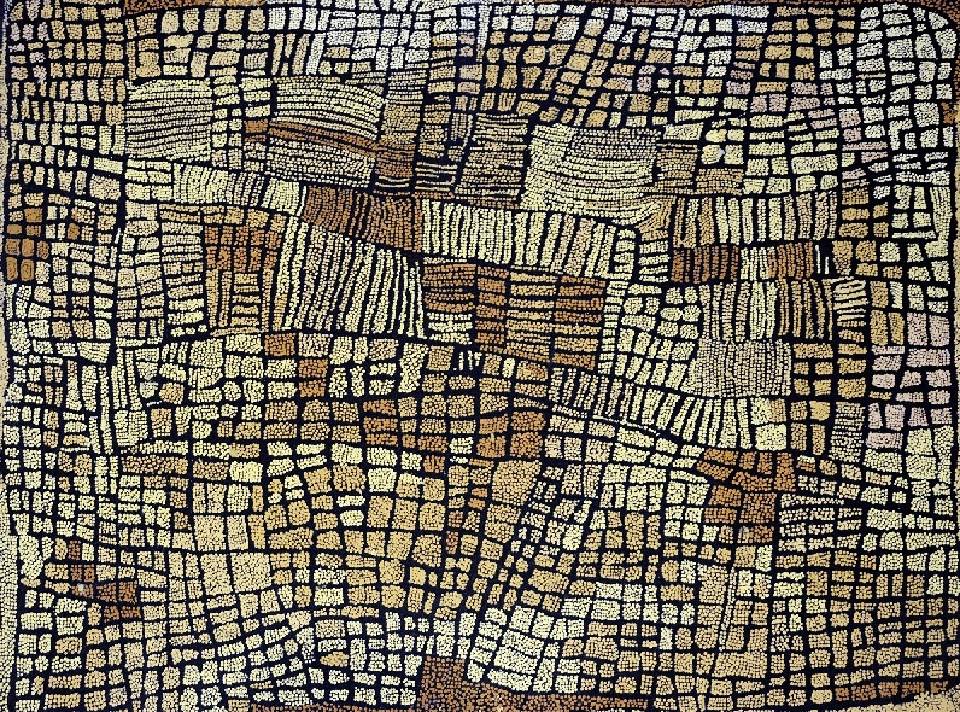Naata Nungurrayi

DOB:
c. 1930 - 2021
Born:
Kumilnga, Pollock Hills, WA
LANGUAGE GROUP: Pintupi
COMMUNITY: Kintore, NT
Naata Nungurrayi was a respected senior Pintupi Elder and recognised as a leading woman artist in the western desert art movement. She was born c.1932 at the rockhole site of Kumil, west of the Pollock Hills in Western Australia. Naata is a full blood sister to the late Nancy Nungurrayi Ross, sister to George (Hairbrush) Tjungurrayi, and mother to Kenny Williams Tjampitjinpa; all highly respected artists in their own right. She lived in Walungurru (Kintore) with Nancy.
In April 1962, Naata and her family were collected by a desert welfare patrol and brought to Papunya Community from the remote desert regions on the Northern Territory and Western Australian border. In one step, they had moved from a fully nomadic, stone age life into western society. Like other Elders of the time, Naata brought with her a knowledge of her country and its Dreamings that had evolved over 60,000 years. It was this deep knowledge that she later expressed in her astounding artworks. In 1982, Walungurru (Kintore) was established by the Pintupi as their main community and Naata quickly moved back to her home country with her fellow Pintupi tribespeople.
Naata, like many women artists from the Kintore and Haasts Bluff communities, began painting in her own right in the mid-1990s after years of contributing to men's artworks through background dotting. This shift was part of a broader movement that empowered women to develop their own careers and tell their own stories through art.
While Naata started painting for Papunya Tula in 1996, it was the opening of the Ikuntji Women's Centre in 1992, the first art centre established by women in the Western Desert Art Movement, that provided critical support for women artists to explore their creative potential. This project was pivotal in giving women the opportunity to express their personal and cultural narratives, which had previously been absent from the mainstream art world.
Encouraged by Marina Strocchi, the Haasts Bluff (Ikuntji) Women's Centre Coordinator, Naata's unique style was immediately recognized. She began painting for Papunya Tula Artists, the Pintupi-owned artist cooperative, and later, collaborated with trusted independent dealers. These dealers worked closely with Naata to explore her Dreamings, pushing artistic boundaries and helping her produce an incredibly compelling and diverse body of work.
The Dreamings that Naata painted depict sacred women's sites and women's ceremonies in the Kintore and Kiwirrkurra region. As an Elder and through her lineage, Naata was one of the few women to have permission to paint certain features of these Dreamings. She developed a distinctive style, quite different to the mens' style of the region. Naata's artistic style is a harmonious blend of geometric precision and organic fluidity, influenced by both Pintupi men's and women's painting traditions.
Using pale creamy ochres and warm and dusty desert colours she imparted a gentle softness to her compositions. The viewer is often struck by the effortless harmony of her art. Her paintings often feature intricate grids and detailed iconography filled in with contrasting dotting. Her understanding of form and subtle use of colour was supreme.
Her paintings are sought by major Australian public galleries and collectors worldwide. Naata's artworks have been exhibited in numerous National Aboriginal and Torres Strait Islander Art Awards ("NATSIAA"), a prestigious Award established in 1984. The Award is one of the premier national events in the Australian Indigenous art calendar. In 2002 (the 19th NATSIAA) Naata Nungurrayi was awarded "Highly Commended".
In 2003 Naata Nungurrayi was honoured with having one of her paintings chosen to appear on an Australia Post International stamp. In 2004, she was named among the Top 50 of Australia's Most Collectable Artists by Australian Art Collector magazine. In 2012, she was featured in the second National Indigenous Art Triennial at the National Gallery of Australia. At the time, she explained:
"I am painting my home, my Countrywomen's Kanaputa story. Travelling along Irrututu, Tjuntupul, Marrapinti, Ngami, Wirrul. A long time ago, I travelled all around this Country, from place to place. I was a young girl at Marrapinti. Walking with my family and two sisters. I came to Marrapinti as a young mother. Travelling with my son Kenny, who was born at Liki. Later, we travelled west to Unkunya, where my other son, Titji, was born. I lost my last child, my daughter, at Unkunya and my husband at Yumurru. It was dry and hot times. We walked east, all the way to Pinpirrnga, drinking from rockholes, sleeping on ground with windbreaks. We then walked to Amunturrngu (Mount Liebig), where we saw the windmill and speared a bullock. After that, we followed the road to Papunya.
Today, I am living in Kintore with my family, sitting down with my grandchildren. I have lost my two sisters. I am the only one. Painting my home. Painting Marrapinti - women travelling, sandhills, rockholes. They pierced their noses at Marrapinti, like this [Nungurrayi gestures to her nose]. Sitting in the cave. Putting little kangaroo bones through their nose. Singing the Tjukurrpa (Dreaming) from a long time ago, singing that Marrapinti."
Throughout her painting career, Naata consistently produced works of the highest calibre while moving freely between Alice Springs and her Country. Naata passed away in September 2021, but her continued influence is evident in exhibitions such as 'EMINENCE' in New York (2023), where Naata was described as being 'at the forefront of women's painting' and that she 'revolutionised the movement through their singular depictions of Country'.
Copyright Kate Owen Gallery, January 2025
